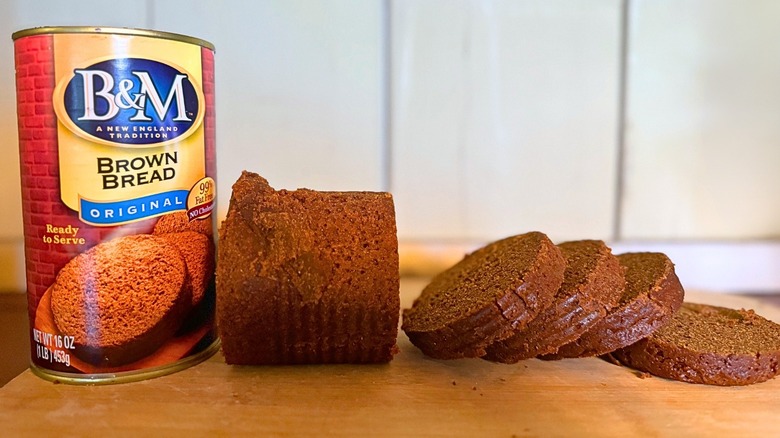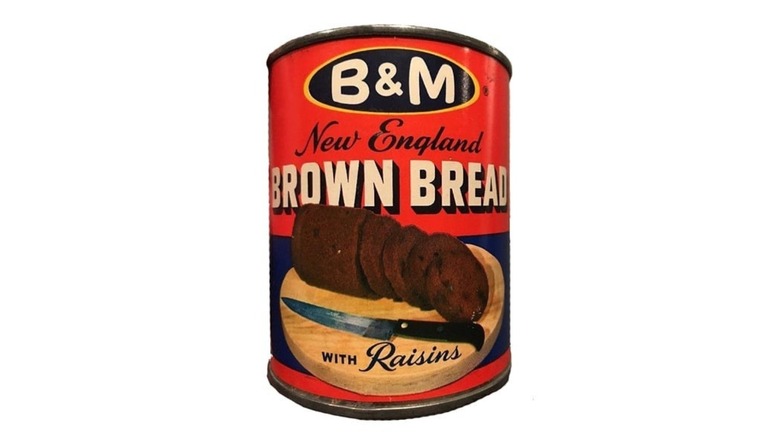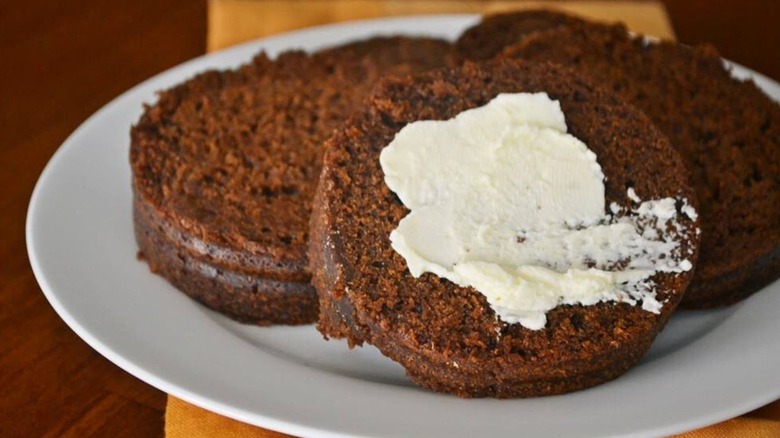The Unexpectedly Deep History Of Canned Bread
Yes, canned bread is a thing — a distinctly New England tradition. You might recall it from the famous "SpongeBob SquarePants" episode where Squidward moves to a utopian town and is overjoyed to find they sell canned bread, an oddly fitting choice for his quirky tastes. Growing up in New Hampshire, I've never tried canned bread myself, but my parents, who have, describe it with a nostalgic fondness.
Canned bread's legacy is tied to the survival instincts of early New Englanders, which might explain the sentimental value it holds for people like my parents. When the first settlers arrived in Massachusetts, they hoped to grow wheat, but the local climate made it difficult. Instead, they turned to more affordable and resilient grains like rye and corn. Lacking ovens, they steamed their bread over open fires, often using cans as makeshift molds.
Later, they gained access to molasses through trade and began incorporating it into their bread to enhance sweetness, resulting in a texture they likened to steamed pudding. This recipe became known as Boston brown bread and quickly became a staple in New England households. The canned bread in grocery stores today carries forward the tradition from when Boston brown bread was steamed in a can over an open fire. Made from the same basic recipe including rye, cornmeal, and molasses, this dense, dark loaf evokes a sense of heritage and resilience, preserving a vital piece of New England's culinary history.
B&M introduced canned bread to America in 1928
B&M, named after founders Burnham and Morrill, opened in 1867 as a canning company in Portland, Maine. Over the years, it tried to can almost anything you can think of, including roasted chicken, oysters, lobster, carrots, and peaches (and if you think that's surprising, check out these other unexpected canned foods). Then in 1928, it launched a product that already held a special place in New Englanders' hearts — canned brown bread.
Today, B&M is most famous for their baked beans. None of its other canned products survived the pressures of supply and demand, leaving B&M's baked beans and canned bread as its only remaining product lines. Canned brown bread, available in both plain and raisin varieties, may not be as popular as it was during World War II, when canned goods were a staple in households due to rationing and limited fresh supplies, but B&M still produces nearly one million cans annually.
Interestingly, the pandemic brought an increase in the volume of internet searches for canned bread, as more people turned to shelf-stable foods. B&M's brown bread has a two-year shelf life, according to the manufacturer, giving you plenty of time to work up the courage for your canned bread taste test. Now, when it comes to actually preparing canned bread, there are some distinctly New England ways to enjoy it.
How to enjoy canned bread
To enjoy canned brown bread, grab a can opener and pop open the can. The bread will slide out in a log shape, complete with ridges around the sides, reminiscent of canned cranberry sauce. The texture is soft and dense, more akin to a cake or muffin than traditional bread. The taste is rich and sweet with the flavor of molasses.
Canned bread isn't really sandwich material. It's commonly paired with butter, cream cheese, or jam. For a true New England experience, try it alongside baked beans and hot dogs. Heat it up to bring out the flavors or enjoy it straight from the can for a more rustic feel. It's versatile enough to be enjoyed as breakfast, a snack, dessert, or paired with dinner. My parents both remember eating it around Thanksgiving and described it as delicious and sweet. Not everyone's a fan though; some people have memories of spitting it out when their parents weren't watching.
If you're drooling to try this, or even just a little curious, canned bread might be difficult to find in stores outside of New England, but it's available on Amazon. No pressure, but one former writer for The Takeout believes skipping canned bread is a cowardly move. All jokes aside, despite mixed opinions on taste, this canned loaf — and its connection to New England's past — continues to hold a special place in the hearts (and pantries) of many.


